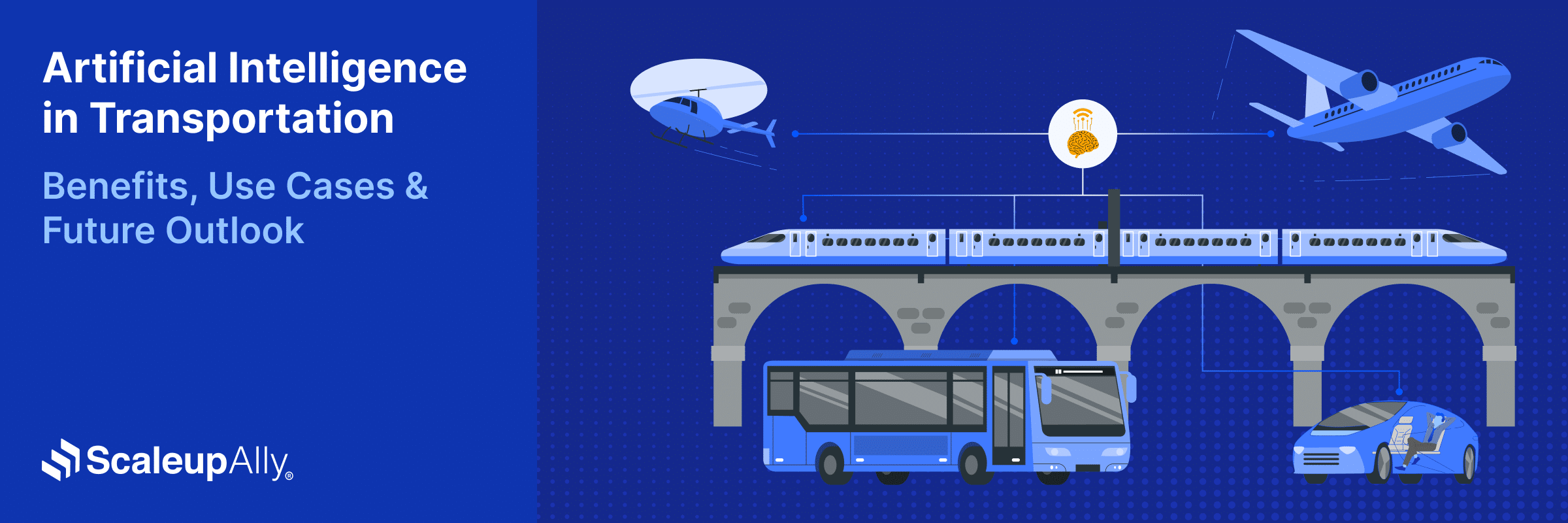
Artificial Intelligence in Transportation: Benefits, Use Cases & Future Outlook
Manu Jain | August 30, 2025 , 11 min read
Table Of Content
Tesla has been granted a permit to operate robotaxis. The “Cybercab,” as Elon calls it, is expected to be on the roads by the end of 2026. The goal is to outsource driving to robots (AI) so that road usage can be safer. This is just one practical application of artificial intelligence in transportation.
In this blog, we bring you other applications of artificial intelligence in the transport industry and how it impacts our lives and the industry in general.
Key Takeaways
- While AI improves safety, it requires huge investments for implementation. It also raises serious privacy concerns about tracking your every move
- 3.5 million truck drivers and millions more transportation workers face automation, creating economic disruption that retraining programs can’t solve quickly enough
- Every vehicle, traffic signal, and pedestrian will communicate in real-time, making commutes predictable and efficient but also creating unprecedented surveillance capabilities
- Autonomous trucks, flying cars, and hyperloop systems are moving from science fiction to reality.
Introduction to Artificial Intelligence in Transportation
- Introduction to Artificial Intelligence in Transportation
- Benefits of AI in the Transportation Industry
- 4 Key Use Cases of AI in Transportation
- Challenges of Implementing AI in Transportation
- Real-World Examples of AI in Transportation
- The Future of AI in Transportation
- Conclusion
- Frequently Asked Questions
The invention of the combustion engine in 1860 brought a massive transformation to the transport sector. Today, artificial intelligence stands another chance to further transform the sector positively.
When we talk about artificial intelligence in transportation, we are simply referring to systems that can distinguish between other vehicles on the road and pedestrians, detect when a vehicle needs maintenance, analyze traffic, and make routing decisions independently, among other things.
We are currently witnessing smartphones predict how soon or how long it’ll take us to arrive at a specific destination. We are also able to tell the traffic situation of specific routes using apps on our phones. In cities like Los Angeles and Hangzhou, city authorities control traffic lights with AI to ease congestion. These advances mentioned however, only represent the surface of what artificial intelligence can achieve in transportation.
The World Health Organization states that each year, 1.19 million people die as a result of road traffic crashes. Not to mention, injuries from road accidents are the leading cause of death for children and young adults aged 5–29 years. Based on these data, it is anticipated that death by road accidents would be completely eliminated with self-driving cars, with the help of the collision avoidance AI technology in these cars.
All transportation systems generate massive amounts of data every second. This data is collected from vehicle sensors, GPS tracking, traffic cameras, and mobile devices. With such amounts of data being harvested, it overwhelms human operators at a certain point. However, we’ve had a helping hand from AI to turn this data into actionable insights that would improve safety, efficiency, and sustainability.
The benefits of AI in transportation are not only on our roads. Port authorities are using machine learning algorithms to optimize container loading sequences to reduce ship turnaround times significantly. We are talking about hours of turnaround time. Another area is aviation. Airlines are deploying technology that detects engine issues as soon as they occur so that they can be tackled before they escalate into serious issues.
The environmental and safety impact of AI is equally significant. Computer vision systems in vehicles can detect pedestrians in blind spots faster than human reflexes. We can also mention low carbon emissions, interventions that prevent accidents, and many more.
However, challenges remain substantial. Data privacy concerns remain a worry as transportation systems collect very detailed movement information. There’s also the risk of cybersecurity because of potential hacking targets. Job displacement affects millions of transportation workers as automation advances.
The technology also creates new inequalities. Advanced AI systems require expensive infrastructure investments that benefit wealthy urban areas first. Rural communities would be left behind in this case. Despite these challenges, growth and rapid expansion are still expected in the transport sector.
Benefits of AI in the Transportation Industry
AI promises to bring massive improvements to the transportation sector, and it has already started. We are witnessing smart transportation systems, predictive traffic management, autonomous vehicle technology, AI in logistics and supply chain, and many more inventions in real time. Here’s a deep dive into some selected few:
1. Reduced Traffic Congestion
Traffic congestion costs the average American driver $1,400 annually in lost time and fuel. This is an expensive problem, and city authorities are working hard to resolve it. One of the ways they are approaching this problem is through AI-powered traffic management systems.
Traffic data from cameras, sensors, and mobile devices is analyzed to understand traffic patterns. The next point is for machine learning algorithms to process this information to suggest alternate routes to drivers and predict where congestion will occur. Unlike static traffic systems, these systems adapt continuously throughout the day.
2. Enhanced Safety and Accident Prevention
Human error causes 94% of serious traffic crashes. With AI at the wheel, this figure can be beaten down significantly. Tesla’s Autopilot has prevented thousands of accidents through automatic emergency braking and collision warnings.
3. Optimized Route Planning and Logistics
The global economy suffers a $1.6 trillion loss annually. To solve this, AI is playing a part in helping goods get delivered quickly and at a lower cost.
AI systems process lots of datasets (traffic patterns, weather conditions, delivery windows, vehicle capacities, and customer preferences). These processed data create optimal routes in real-time. These recommendations are continuously improved by analyzing successful deliveries.
4 Key Use Cases of AI in Transportation
These machine learning transportation applications show artificial intelligence tackling real-world problems:
1. Autonomous Vehicles and Self-Driving Technology
Self-driving cars are the most familiar way we see AI in transportation today. Companies like Waymo are already running fully autonomous taxi services in cities such as Phoenix and San Francisco without human drivers. Tesla is also pushing the boundaries with its Full Self-Driving system, which uses eight cameras and a suite of sensors to make driving decisions.
2. Smart Traffic Management Systems
Traffic lights used to follow rigid timing patterns regardless of actual conditions. Now they learn and adapt. Cities install AI systems that monitor traffic flow through cameras and embedded sensors, then adjust signal timing to keep vehicles moving.
3. AI in Public Transportation Optimization
Bus and train systems serve unpredictable passenger demand with limited resources. Public transit agencies leverage artificial intelligence to improve service reliability and passenger satisfaction. Some transit agencies can now adjust bus frequencies in real-time, sending extra vehicles to routes experiencing unexpected demand while reducing service where ridership is light.
4. Route Optimization and Logistics Planning
FedEx processes 15 million tracking events daily through machine learning systems that constantly recalculate optimal routes. The AI considers driver break requirements, fuel costs, package weight distribution, and even the probability that someone will be home to receive a delivery.
Amazon takes this further by predicting what you’ll order before you order it, positioning inventory closer to likely customers. This reduces delivery distances and speeds up the entire process.
Challenges of Implementing AI in Transportation
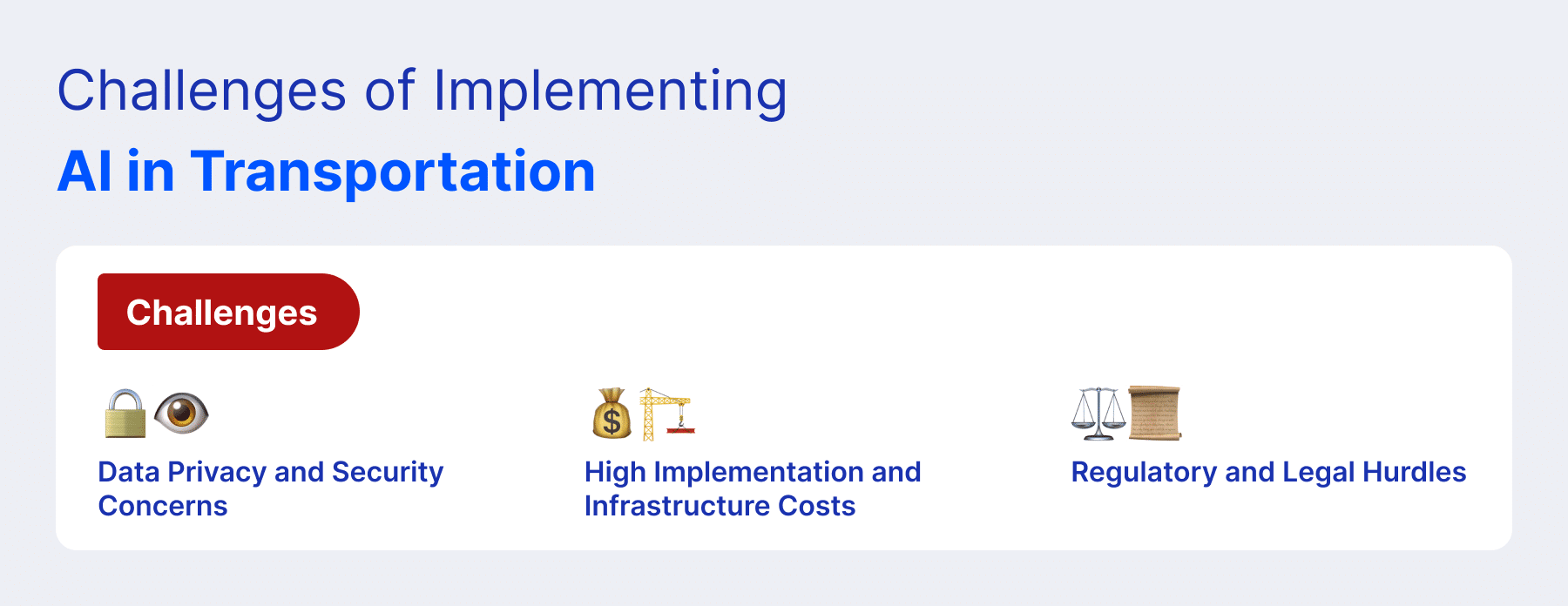
Transportation companies love talking about AI’s potential. Yet, they’re less eager to discuss the downsides.
1. Data Privacy and Security Concerns
Every trip you take generates data someone wants to monetize. Ride apps know where you live and work. AI embedded cars track how fast you drive, when you brake hard, and which routes you prefer.
This information goldmine attracts hackers. When criminals breached Uber’s systems in 2022, they didn’t just steal credit card numbers. They got detailed movement patterns for millions of people. Stalkers dream of this kind of access.
2. High Implementation and Infrastructure Costs
Building smart transportation is expensive. A single intersection upgrade can cost $250,000 to $500,000 when including AI-capable traffic controllers and connectivity hardware.
Smaller municipalities and developing regions get left behind completely because they lack fiber optic cables and 5G towers that AI systems need. The technology gap widens between rich urban cores and everyone else.
3. Regulatory and Legal Hurdles
If a self-driving car kills someone, who goes to jail? The programmer? The car company? The owner sleeping in the passenger seat?
Each state has its own set of laws. Some jurisdictions welcome self-driving car pilots while others ban them entirely. Companies waste millions navigating this regulatory maze.
Real-World Examples of AI in Transportation
Some real-world examples where AI is hugely dependent on in the transport industry.
1. Singapore and Its Traffic Light System
Singapore’s AI traffic management system adjusts signal timing every few seconds based on real-time vehicle flow. The system learns from patterns. School zones get longer pedestrian crossing times during dismissal hours, while shopping districts receive priority during weekend traffic surges.
Emergency vehicles like ambulances approaching intersections receive precedence by automatically triggering green lights in their direction while stopping conflicting traffic.
2. Delta Air and Predictive Maintenance
Delta Air Lines uses AI to predict airplane maintenance. Their predictive systems analyze data from 100,000 sensors across their fleet. This is lifesaving. Aircraft maintenance AI has helped reduce mechanical-failure accidents to nearly zero across major airlines.
3. Uber’s Algorithm Juggles Millions of Rides
Every second, the platform considers thousands of ride requests, available drivers, traffic conditions, and pricing factors to create optimal pairings.
New Year’s Eve, major sports events, even sudden rainstorms trigger automatic driver positioning. The system knows that more people request rides when it starts raining, so drivers get notified to head toward busy areas.
The Future of AI in Transportation
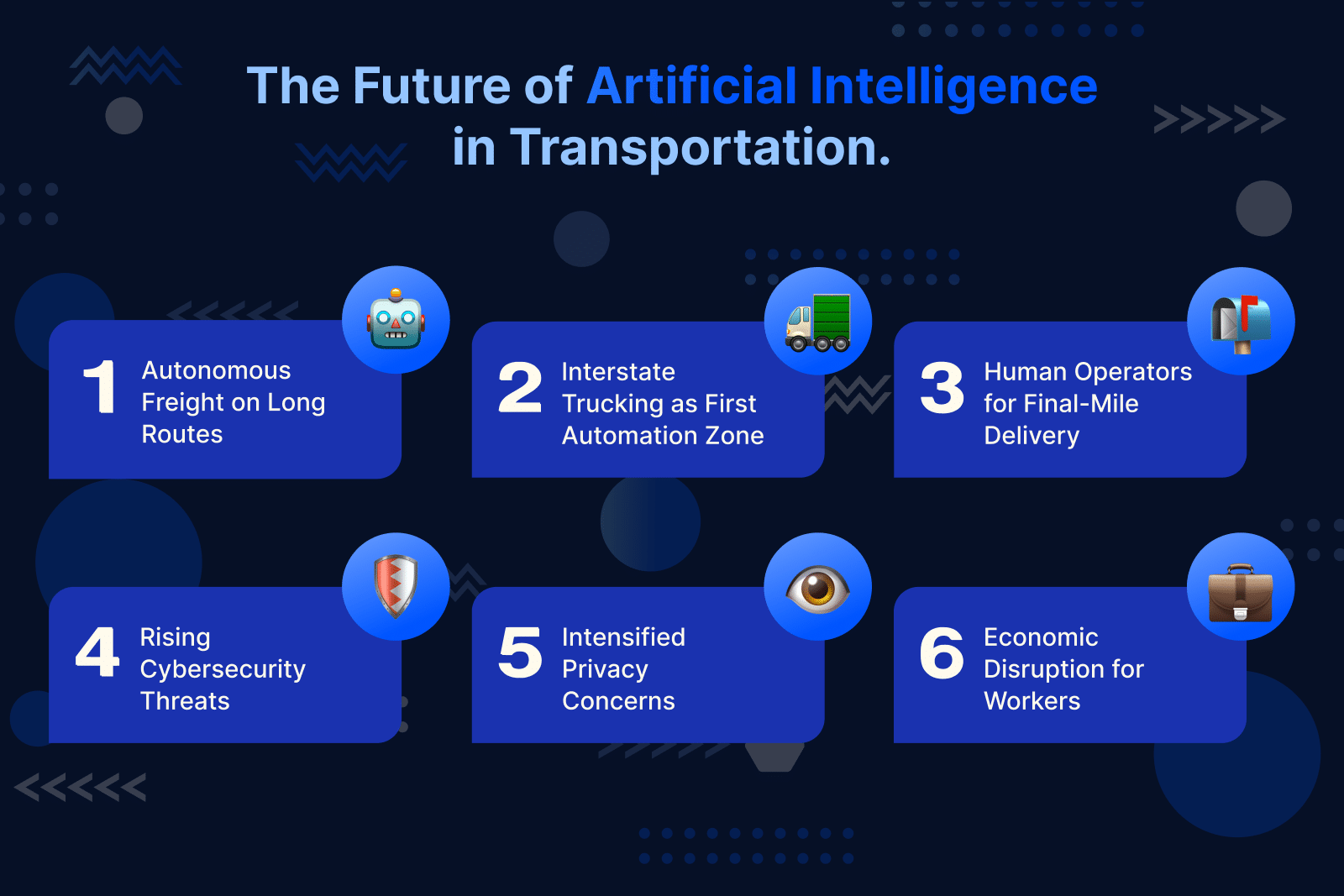
Autonomous freight will dominate long-distance routes within fifteen years. Interstate trucking presents fewer variables than urban driving, making it the logical entry point for full automation. Human operators will transition to final-mile delivery roles where complex customer interactions still require personal judgment.
However, these advances create new vulnerabilities where transportation networks become attractive targets for cyberattacks. Privacy concerns will also intensify as movement tracking becomes ubiquitous. Economic disruption will affect millions of transportation workers too, whose skills become obsolete.
Conclusion
Transportation’s AI revolution accelerates whether we embrace it or resist it. Success requires more than buying new technology. It demands rethinking mobility from scratch. Ready to future-proof your transportation business or app? Contact us to discover how AI can transform your operations before your competitors do.
Frequently Asked Questions
Q: Is AI in transportation safe?
AI transportation systems have better safety records than human drivers in controlled conditions. Waymo’s autonomous vehicles completed over 1 million miles without at-fault accidents. However, AI struggles with unusual situations like construction zones or severe weather that humans handle instinctively.
Q: How does AI improve traffic management in cities?
Smart traffic systems analyze real-time data from sensors and cameras to optimize signal timing automatically. AI predicts congestion patterns and adjusts routes before traffic jams form, keeping vehicles moving efficiently.
Q: Can AI help reduce transportation-related accidents?
Computer vision and predictive analytics prevent crashes before they happen. AI collision avoidance systems prevent 40% of rear-end crashes and 37% of lane departures. Fleet operators using driver behavior monitoring see accident rates drop 60% within the first implementation year.
Q: What impact does AI have on reducing fuel consumption in transportation?
Machine learning optimizes acceleration patterns, routes, and load distribution to minimize fuel waste. UPS saves 10 million gallons annually through AI routing. Trucking companies typically see 8-15% efficiency gains from AI-powered fuel management systems that consider traffic and terrain.
Q: How does AI in transportation improve passenger experiences?
AI personalizes services based on individual preferences and travel patterns. Ride-sharing apps predict demand and position drivers to reduce wait times. Public transit uses passenger flow analytics to prevent overcrowding and adjust schedules for smoother journeys.
Related Blogs

OpenAI for Businesses [Benefits, Use Cases & Challenges]
Discover the benefits of OpenAI for businesses. From reducing costs to scaling operations and enriching customer experiences. Real-world use cases included.
ScaleupAlly Team
Dec 16 ,
11 min read
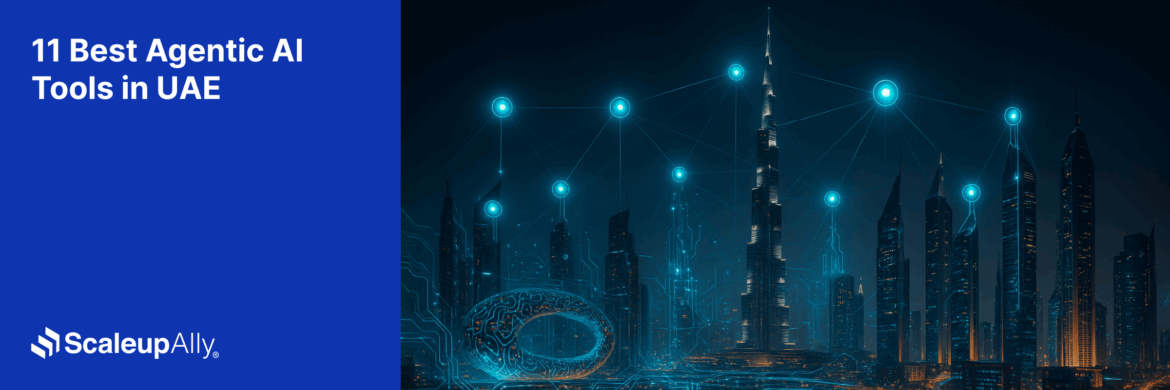
Best 11 Agentic AI Tools in UAE: Accelerating Digital Transformation
Discover the top 11 agentic AI tools in UAE for 2025. Explore features, benefits, and tips to choose the right AI tool for your business growth.
Manu Jain
Nov 6 ,
9 min read
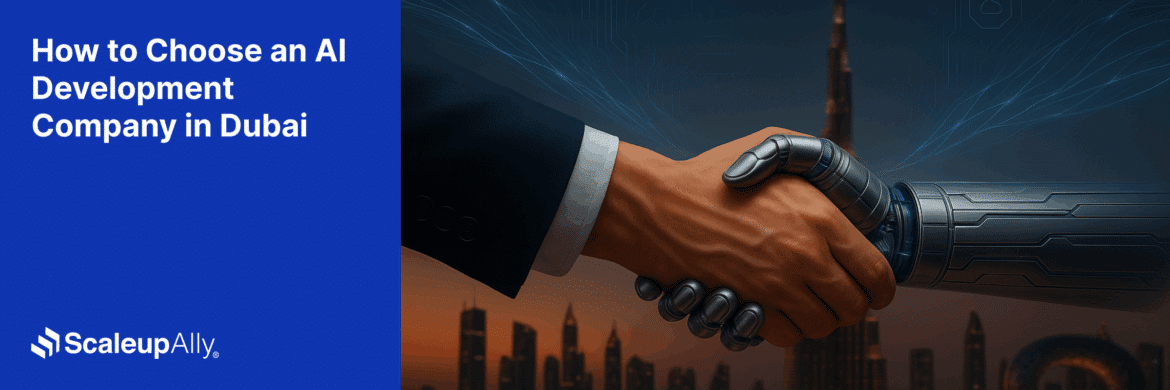
How to Choose an AI Development Company in Dubai: A Complete Guide
Find out how to choose the right AI development company in Dubai. Learn key factors, local considerations, and tips to select the best partner.
Manu Jain
Nov 6 ,
9 min read


